#mongolian folk religion
Note
Wait isn’t “christo-tengri shit” like a legitimately historically significant belief…like wasn’t there some significant guys in crusades times who believed there was a secret kingdom of mongolian christians who would be important in the conquest of the holy land or something? there’s definitely something there keep cooking
Tengriism and Christianity absolutely interacted historically. As for the secret Mongolian Christians, you might be thinking of the legend of Prestor John.
"Judeo-Tengriism" is a reference to a historical occurrence that's a bit of a favorite among theology students, the correspondence between Rabbi Hasdai ibn Shaprut, and Joseph King of the Khazars. Through traditionally a Tengriist people, the king convened a council of the three leading faiths, Christianity, Judaism, and Islam, to choose which religion his empire would convert to. The rabbi won the debate, and King Joseph converted to Judaism, though it seems that most of the empire kept doing whatever they were already doing.
Thus, speculation on Judeo-Tengriist syncretism is a bit of a meme in theology circles. It's a fascinating historical moment, but also one so niche and scarcely documented that it's easy for speculation to leave the realm of the reasonable. Before long you end up with wild legends of armored Rabbi-Shamans astride mongol armies, and conspiratorial theories of Secret Jewish Khazarian Mafias.
In reality, King Joseph's motives were likely genuine, but political. It's unlikely that Judaism and Tengri ever seriously syncretized. Hence jokes about this theoretical folk syncretism of Judeo-Tengriism being the Ultimate Based One True Religion.
603 notes
·
View notes
Text
I finally had time to make proper designs for the Trio!
Redson: Ver 1
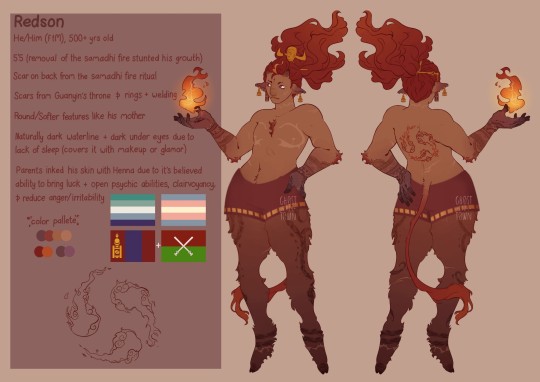
Ver 2

I couldn't decide on if I liked it better with the braids or not so I just posted both, but anyways!
I gotta admit, I used to not like the idea of redson having Bull features (except for a small pair of horn maybe) but the concept really grew on me and now I really love it and wanted to try making my own design and I'm really proud with how it turned out.
I would've added more scars, since Guanyins throne pierced his entire body, but there came a point where it just looked like there was too much going on so I had to get rid of a few scars to tone it down, so we're just gonna say they faded over time, okay? Okay.
I also made him Miao (one of the largest ethnic minorities in southwest China) on PIF's side, and Mongolian on DBK's.
The Miao ethnicity of China has a long history, rich culture, and an ancient folk religion. Adorned in beautiful traditional clothes, possessing natural talent for singing and dancing, they live in uniquely designed indigenous architecture, which I think fits perfectly with how I imagined Princess Iron Fan and with her; Redson.
As for DBK being Mongolian, I saw someone else talking about this headcanon and I just liked it so I decided to use it, I don't really have a specific reason for it, I just thought it fit, not sure why though, it's just one of those things that makes sense even if you don't know why, you know?
Mei:
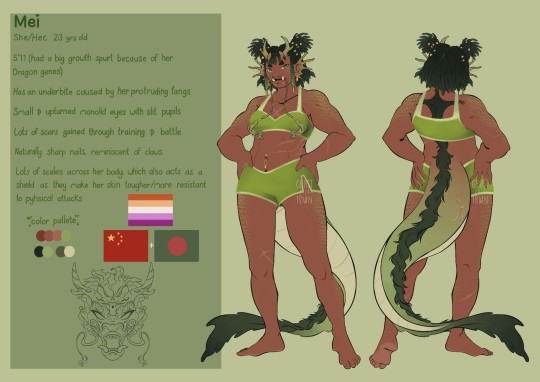
I made her taller and gave her a long dragon tail (like really long, it drags along the floor if she's not holding it up), though her scales are pretty much everywhere across her body they're most noticeable on her shoulders, thighs, and face (they're a bit hard to see in this photo because they're kinda hidden behind her hair, but I did give her scales beside her eyes)
I also gave her horns these little spiral designs around them, gave her sharper nails, and designed her ears to look like coral, since she's a water dragon and I thought they looked cool.
Honestly idk what else to say about her design, I didn't have anything specific in mind when designing her, I kinda just had to wing it, but I'm happy with how it turned out :)
(I also made her Bengali, on her dad's side, but it's not really important or has any reason behind it, just a headcanon I've had for a while, don't know where it came from though)
MK:
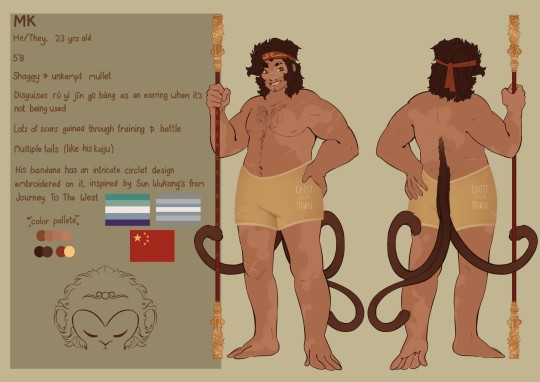
Alot of people have speculated that the monkey form we see during the fight against Azure in season 4 isn't MK's full form yet, that we're just seeing a fraction of what he's yet to become, based on the fact that while he has the weird side burns, the tail and the face marking, he also lacks a natural skin tone, they didn't give him a proper nose etc, so I wanted to play with the idea.
I decided to make him this strange mix between human and monkey, leaving him pretty much human with the addition of his tail(s), and weird li'l monkey feet.
(I was also gonna give MK more arm/leg hair, it was in my first sketch, but I forgot to add them when I was doing the line art and didn't realize until after I saved it as a jpeg, so that's my bad, but I'm gonna add it in to any other art I make)
It's also a bit hard to see in this, but I designed his staff with more details, specifically adding dragon-esque imagery to the Golden ends, this is because (for anyone who's new to the fandom/hasn't read JTTW) Wukong's staff was originally one of the several pillars that held up the sea in the dragon palace, until he stole it and shrunk it down to use as his weapon.
I also did MK's clones :)
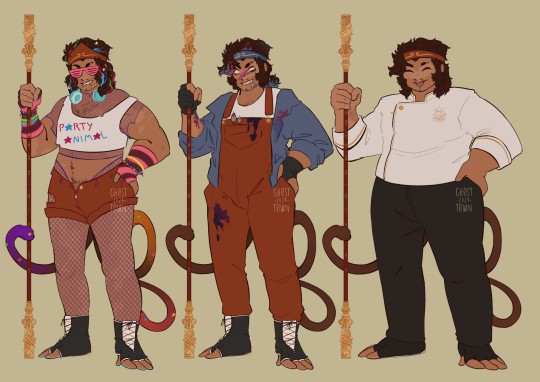
Porty MK:
I gave him stripes of coloured hair and gave his tails all different colours, though I don't think he would actually dye it, instead I like to think that he would use that really crappy dollar store spray in hair dye (or hair chalk). I kept the fishnet clothes that I added in my originally design of him for my headcanons post, and decided to give him striped elbow length fingerless gloves.
I also gave him a cropped shirt, ripped shorts and these weird fingerless glove-esque shoes for convenience, since regular shows seem like they would be uncomfortable.
Edit: my dumbass forgot Porty's stupid print jacket 😭
Artist MK:
For Artist MK I gave him overalls and a jacket over it, which he wears specifically for when he's doing paintings so he doesn't ruin too many of his actual clothes (I know I said that this was inspod by Circusapple, which it still is, but this is almost exactly what I wear when I'm painting too, just in different colours).
I also gave him those gloves that digital artists wear so they're hands don't accidently trigger something on the screen because everyone knows that every artist just walks around with their art glove on even when it's not necessary.
Delivery MK:
I have to admit, I was never a big fan of MK's work uniform just being his regular clothes with a work jacket thrown over it so I wanted to try and make him look a little more professional and decided to instead give him a chef coat (similar to the one Pigsy wears on the show as well), with a logo for the restaurant on the chest, along with it I gave him plain black pants, since casual red jeans didn't seem very professional (I know he's just a delivery person, but if you were to look at pretty much any food corporation, even people who do deliveries have to wear uniform, so it's always been kinda strange to me that he's just in regular clothes).
The shoes were harder to make professional given the whole "half-monkey" thing so I opted to give him the same strange fingerless glove-esque shoes for comfort and convenience, but made them plain black as well.
#lego monkie kid#fanart#lego monkie kid red son#monkie kid red son#lego monkey kid fanart#red son#lego monkie kid mk#lmk spicynoodles#lmk mk#hong hai'er#lmk mei#lego monkie kid mei#monkie kid mei#long xiaojiao#qi xiaotian
326 notes
·
View notes
Note
Have you seen the creepy video about Dalai Lama straight up kissing a boy? I hate men and religion so much
i am guessing it's that asian elder generation gap, some of the stuff the old folks in some countries there are like 'this is acceptable' is wild. but that doesn't make it okay, preventing the normalisation of violating children's boundaries as adults is so important in preventing sexual abuse.
but i don't think it was a case of intentional predation. kissing on the mouth in some cultures does not have sexual connotations. i have complicated feelings. many tibetans can be blinded because they see this man as a literal holy figure, and men have used that shield in many cultures and religions to abuse children. it is also easy to become highly defensive when it feels like the world is judging your cultural practices, right or wrong. but also, it is suspicious that this video blew up months after it was posted online, and it blew up shortly after the dalai lama announced a mongolian AMERICAN boy as the reincarnation of a buddhist figure, which was extremely strategic, because the last new figure the dalai lama announced was immediately abducted by the ccp and basically never seen again.
here's an article that shows the more tibetan side. though this doesn't change that 1. i'm anti religion and 2. i am anti men, or any adult, violating the boundaries of children just because they can. i think that's the case, even when much of the time, due to culture, the touching is not considered sexual in nature by either the adults or children (when they have grown up). bodily autonomy is key in raising a healthy, patriarchy, and hierarchy free community.
#and is something i have a little more knowledge on compared to tibetan culture specifically#both on and off topic but i just recently read more about something i already knew a little about#there's still old people in some asian countries that still do this today#but back in the day because boys were highly valued over girls#relatives and even strangers would just ask to see little boys' penises#and play with them with their hands and even MOUTHS#it was like a sign of pride and affection of maleness#actually fucking insane#i've heard directly from korean men humiliating memories of their grandparents and uncles and other adults forcing their pants down#and touching them in front of their entire family#a 'gochu' culture pre 2000's#and this was a thing in some other neighbouring countries too#i think with both this and the dalai lama thing it's symbol of how recently globally children have transitioned from property to people#older folks think that because they're an adult and children are property that children don't have rights and they can do whatever
36 notes
·
View notes
Text
More characterization and headcanons: religion/faith
So I looked up a bit of Tengrism, mayhap what unifies steppe people more than language ever could as this is tightly connected to the steppe life and culture, and considering now Central Asias to Turkey are mostly Muslims and most Mongolians are Buddhist, I thought to myself like… do steppe people feel that their heart ‘branches out’ in two directions?
In a way like, I’m gonna speak a bit about myself now, but for typical Javanese people pure (sharia) Islam has a feel of ‘foreignness’ in it. We traditionally have our own faith system; we began as Animists, then when Hinduism and Buddhism came we absorbed them into our faith. The result was some kind of syncretism and we’re actually good at it; the Javanese traditionally think that all God(s) are the same you know, doesn’t matter what religion it is. The truth of all religions, the absolute God in them, is basically the same. That’s why we readily syncretize everything. When Islam came on much later, it was the same. We syncretized further and it resulted in a faith system that was a mix of Animism, folk faith, folk Islam, sufi mysticism, Hindu-Buddhist influences etc. I regard this as a traditional way of the Javanese.
Today, we’re all more religious in a sharia way. I think everyone knows how zealous ‘pure sharia’ Muslims can be, well, basically. Abrahamic peoples lol. For me personally tho, even as Muslim, this form feels pretty foreign. And no, I don’t rly believe that sharia is the only way to be a proper Muslim. Just like a typical Muslim I feel in my heart Muslim brotherhood and sisterhood with Muslims from all over, and I feel fondness for sharia Islam as well, but in the end it’s pretty foreign.
I wonder if all steppe people feel a similar thing deep in their heart in regards to Tengrism or even the more syncretic form of faith, and the ‘pure’ version of religions they adopted later. Central Asia is notoriously known for not being Muslim enough and it’s not just due to Communism; the people there were largely nomadic, and nomadic way of life is not very compatible with Islam even if Central Asian nomads have been Muslim since centuries before. Even when people started being settled, they were still at best nominally Muslim. Of course not all countries in Central Asia are the same in religiosity: Uzbeks and Tajiks are generally regarded as most religious, but they were settled, and they are I think most experienced with sufism. I don’t know how Buddhist Mongolia is because I can’t really check myself, but Buddhism might be more compatible with nomadic life/Tengrism and is thus able to accommodate it? Though the few random videos I watched about average people there don’t seem to be much having Buddhist influences (according to what I know about the religion). I’ll endeavor to research more lol.
In regards of my OCs though (Mongolia included), I try my best to match them with their collective people, but in the end they’re also individuals and they might not necessarily reflect their own people at large. Like, basically sometimes I just give up on matching them and pick up certain traits that I think suit them as individuals, not just as the soul of their nations lol. I create OCs mainly to practice on designing and storytelling skill, and less about being a purist nerd.
Mongolia deeply respects and is fond of Buddhism, but he personally is closer to his traditional Tengrism than pure Buddhism. He doesn’t really care what religious label he’s put under tho. As far as he’s concerned, he’s just a nomad and he follows traditions and values that make most sense to his way of life.
Golden Horde was also still largely Tengrist even when his princes and princesses became Muslim. When Islam became the state religion of Golden Horde during the time of Uzbek Khan he might say he was a Muslim, but in the end he still stuck to his traditions as a pure nomad.
Kazakhstan sways between more-Muslim and less-Muslim sometimes. If asked he will probably say that ‘I am a Muslim, BUT—‘. He’s also still quite unfamiliar with many Muslim practices as it is. Does seek God tho when he’s really depressed (alcohol first tho. That’s haram).
Uzbekistan is a proud Muslim, also dabbles in theology and scholarly stuff, and is a student under sufi masters. Might have been some kind of smooth rebel sometimes under Communist era (Uz might look soft and friendly, but he is actually very firm at heart).
8 notes
·
View notes
Note
im mongolian, and i can say this, we’re not like 100% buddhists
our Buddhism is like a mix of shamanism, tengirism and buddhism
and most ppl i know are not very religious, we don’t go to temples often, or pray. but at the same time we’re not 100% atheists too lol
Ohh I see ^.^ yeah I've read about Buddhism in Mongolia being kind of a blend of folk religion too. Thank you for telling me!
3 notes
·
View notes
Text
Geo-Cultural Groups
Europe:
-Caucasian: mountains
-Sarmatic Plains: Swamps, woodlands, plains, and small Vikings élite
-Balkanatolia: heartland of Hellenic civilization
-Italic: (North) City States & Germandom, (Mid) Papal states, (South) Byzantine and Norman Polities with Islamic influence
-Iberian:
-Nordic:
-Variscidia: Aside from the Papal states, Variscidia was the heartland of catholic powers during the early middle ages. It’s cultural background was a syncretism between Latin and Germanic traditions. Variscidia was the region of Europe that served as a bulwark against northern pagan Europeans, Eastern-Oriental Christendom, and Islamic expansion.
-British Isles:
-Visigrad: Transitionary phase into western Europe, Catholicism, Slavs and Steppe peoples (mongols, avars, gepids and magyars)
Asia:
East Asia:
-Tibetan Plateau:
- Northern River Basins:
-Southern River basin
- Goguryeo Mountain Enclosure:
-Mongolian Steppe
-East Asian Desert Complex
-Japanese Archipelago:
North Asia:
-Siberian Plateau (Eastern Mountain Complex, Central Mountain Complex)
-Siberian Plain
-Kolyma
-Yakutsk Basin
-Central Asian Desert Complex (West Asian Mountain Complex Included)
Southeast Asia:
-Indochinese Peninsula
-Malay Archipelago
Indosphere:
-Deccan Polities:
-Indo-Gangetic Polities:
Oceania:
-Polynesia
-Micronesia
-Melanesia
Middle East:
-Levant:
-Arabian Peninsula:
-Mesopotamia:
-Iranian Plateau:
Africa:
-Sahelian Kingdoms: Muslim & Sahelian, mounted warfare
-Guinean Kingdoms: Forested & Folk Religions
-Nile Kingdoms: Egypt, Nubia, axum
-Maghreb:
-Kongo Kingdoms:
-Lake Kingdoms:
-Kalahari Plateau:
-Swahili City States:
North America:
Appalachian Woodlands: Iroquoise & Algonquian, wooded, Haudenosaunee, long houses
Great Lakes:
Mississippian Ideological Interaction Sphere: Chimakuan, woodlands, mound builders, south east,
Great Plains:
Great Basin: aztec tanoan, "Desert Archaic" or more simply "The Desert Culture" refers to the culture of the Great Basin tribes. This culture is characterized by the need for mobility to take advantage of seasonally available food supplies. The use of pottery was rare due to its weight, but intricate baskets were woven for containing water, cooking food, winnowing grass seeds and storage—including the storage of pine nuts, a Paiute-Shoshone staple. Heavy items such as metates would be cached rather than carried from foraging area to foraging area. Agriculture was not practiced within the Great Basin itself, although it was practiced in adjacent areas (modern agriculture in the Great Basin requires either large mountain reservoirs or deep artesian wells). Likewise, the Great Basin tribes had no permanent settlements, although winter villages might be revisited winter after winter by the same group of families. In the summer, the largest group was usually the nuclear family due to the low density of food supplies.
Oasisamerica: Pueblo, cities, agrarian
Plateau:
Californian: The Pauma Complex is a prehistoric archaeological pattern among indigenous peoples of California, initially defined by Delbert L. True in northern San Diego County, California.The complex is dated generally to the middle Holocene period. This makes it locally the successor to the San Dieguito complex, predecessor to the late prehistoric San Luis Rey Complex, and contemporary with the La Jolla complex on the San Diego County coast.
Northwest Coast:
Arctic:
Subarctic:
Mesoamerica:
South America:
Andes:
Amazon:
Plains:
Australia:
Blaze
0 notes
0 notes
Text
Blog Post #3, Worldview
Just over 50% of Mongolians claim Buddhism as their religion, with approximately 40% atheistic, and 2-3% claiming Shamanism. As can be seen from just this small assortment of data, Mongolia presents a varied spiritual landscape. The form of Buddhism commonly practiced in Mongolia has been influenced by a host of various belief systems. Mongolian Buddhism has been influenced heavily by beliefs found in Mongolian folk religion. Cultural expressions of these folk religions can be seen in gift giving practices common in Mongolia. A gift that “opens downward” such as a bell or hat is seen as bad luck, and those that “open upward” are seen as good luck. As with gift giving customs, culture surrounding death in Mongolia is influenced by folk religion. A common practice in Mongolia is that of an open burial, or one in which the deceased is not buried. It is believed that placing the deceased inside the earth is disrespectful to the gods within, and also that burial makes it harder for the spirit to be free from the body.
Worldview in Mongolia is incredibly varied. Differing religions are tolerated in Mongolia, as is evident by the list of religions found on the CIA world factbook. Mongolia is a land with a rich, complex spiritual history, one that continues to be added to currently.
0 notes
Photo
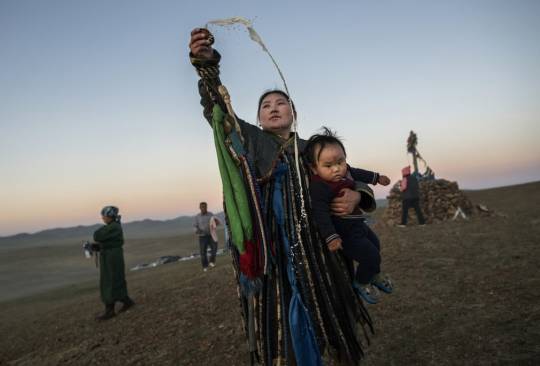



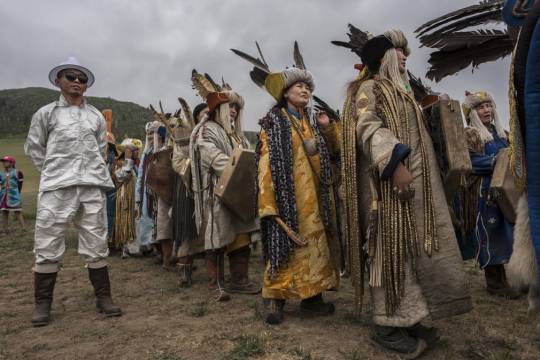


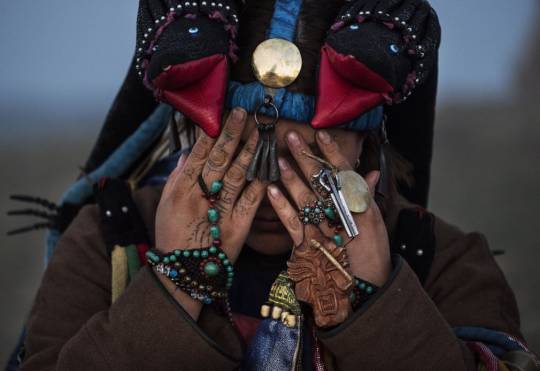

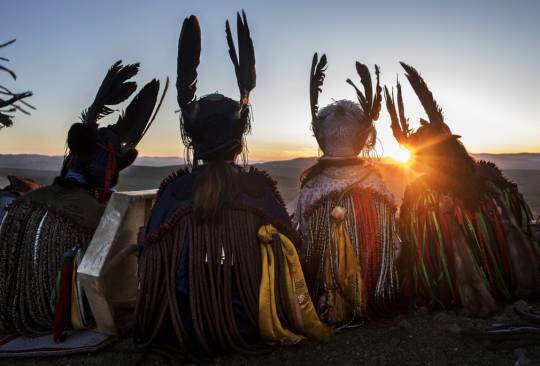
Banned for 70 years under communist rule, the ancient practice of shamanism has been protected by Mongolia’s constitution since 1992 ( 📸 The Guardian )
“Shamanism is a historical memory for people who lost parts of their ancestral homeland, and who had been marginalized and politically oppressed,” adds Buyandelger, an associate professor of anthropology at MIT. It flourishes, she notes, where people have “no museums, no libraries, no cemeteries, no mausoleums. They don’t have anything to materialize their memories of the past.”
- Manduhai Buyandelger ; Tragic Spirits: Shamanism, Memory and Gender in Contemporary Mongolia
The main rite of Mongolian shamanism is to worship and sacrifice heaven. Shamanism venerates the blue sky and green earth. Mongolian shamanism has 55 deities (Tenger or Tengri) of the west who are well disposed towards humans and 44 deities (Tenger or tengri) of the east who cause all misfortunes. Mongolian Shamanism worships 99 deities, in total. These deities protect the clans or tribes, including individual persons, before the power of nature. In Mongolian shamanism, there are water spirits (lus), and mountain spirits (savdag), as well as souls and amulets.
In Tengriism, the meaning of life is found in living in harmony with the natural universe. Tengriist believers view their existence as sustained by the celestial blue sky,Tengri, the fertile Mother-Earth, and life-spirit Eje. Heaven, Earth, the spirits of nature and ancestors provide for every need and protect all humans. By living an upright and respectful life, a human being will keep his world in balance and experience prosperity, well-being and success. Shamans play an important role in restoring balance when a disaster or illness occurs.
#mongolia#mongolian shamanism#shamanism#tengri#tengriism#mongolian history#mongolian spirituality#mongolian folk religion#siberian shamanism#shaman#ritual#ceremony#seance#spirituality
50 notes
·
View notes
Text
What music each of the legions listens to:
Dark Angels- Classical music. They probably really like symphonic and orchestral like 2 Steps From Hell.
Emperor's Children- The weirdest playlist of Marilyn Manson, Twisted Sister, and the Spice Girls. Also Pornogrind.
Iron Warriors- Industrial metal, like... Rammstein. Also they REALLY like looking smart by overcomplicating genre names („Oh I LOVE brutal-slamming-post-heavy-industrial-prog-grunge-core")
White Scars- So the obvious here is Mongolian throat singing, but given their affinity for bikes and the fact that Kahn was described as intellectual, I'm gonna say they also like some classic rock (like Led Zeppelin and Rolling Stones)
Space Wolves - Viking/Folk metal. Come on. They also listen to Pink Floyd, but ONLY when fighting Thousand Sons. („We don't need no education" is a line that is basically the ultimate middle finger to Magnus.)
Imperial Fists- I think they rarely listen to music. But when they do, I imagine them listening to some sad country songs, like Johnny Cash.
Night Lords- The Cure, Evanescence, MCR, Bring me the Horizon... Just... All the emo and Goth stuff. (Konrad really liked Panic! At The Disco's new stuff but they protect that knowledge like it's a new webway project)
Blood Angels- The Blood Angels listen to Linkin Park and Slipknot, despite the fact that Sanguinius himself owned and ukulele. (He prolly really liked Twenty One Pilots)
Iron Hands - Metallica and Iron Maiden. Exclusively. They only listen to them because of the name.
World Eaters - Deathcore, Goregrind, Slam, ya kno. Brutal stuff. (Angron liked the Bee Gees)
Ultramarines - Music is inefficient and doesn't serve the imperium. -_- (But Roboute Guilliman learned terran history from Sabaton lyrics)
Death Guard - Slug Metal, Doom Metal, Drone, Noise... They don't really like music per se, they just like to have some sort of ambient noise, and lo-fi is too melodic.
Thousand Sons - Prog stuff. Tool, King Crimson, Opeth... I would also say Magnus himself really likes Jazz.
Sons of Horus - Limp Bizkit. On repeat.
Word Bearers - Prolly some sort of christian/redneck rock. Erebus specifically likes Nickelback.
Salamanders- Reggae. Just some really chill stuff. (Imagine Vulkan burning people alive to „Sunshine Reggae.")
Raven Guard- Punk. All the Punk. Descendants, Ramones, Offspring, Sex Pistols, Bad Religion, Green Day... ALL the Punk. (I would bet the Emperor's life Corvus was in an underground band back in Deliverance)
Alpha Legion - That one playlist of cursed mashups on YouTube.
147 notes
·
View notes
Text
Yuan Dynasty fashion described in a very mix-n-match fantasy setting
@sylhorn asked:
So I’m writing a story where one of the main protagonists is East Asian. The setting is fantasy, and I aim to make all of my cultures diverse and mixed - for one country, I’m combining several dominantly European in origin pre-Christian elements with some ideas from, for example, the Achaemenid Empire; I pick and choose and throw in fantasy to make it sense (therefore it’s not really inspired by one specific period, rather than just picking out a concept and working from those bare bones, if that makes sense). For the country my PoC character in question is from, I decided to mix certain concepts from Yuan Dynasty China, Heian period Japan and a twisted form of the Augustan Principate of the Roman Empire, thrown in my own religion system (which is a sort of constant thorough the continents, but it varies how they refer to the gods of the pantheon, who they revere more and how their religious rituals look like and what reigious figures are capable of doing, so that’s just another fantasy element on top of the whole mix), put on a mostly mountainy terrain which affects some things (like products that could be used to emphasize the inspiration taken from certain eastern-asian regions might not be present), etc.
I think I have the cultural elements and how they affect the character in question (and his own special circumstances) quite in check, I did some reading, and I think I can showcase how the culture is different from the one the other protagonist is used to. My problem is that I want to describe clothing that is mainly inspired by Yuan Dynasty fashion (which is already a mixed thing, but I intend to take some inspiration from other cultural clothing styles from other periods as well), but I have to do that without the very specific terminology, I suppose? I thought this would be important in comparing the two main characters, as the other one finds aesthetics in general very important, and upon their first meeting, she will definitely make note of his (and the people around him) clothing, because it is different than what she is used to. I planned on this being one of the ways to introduce this culture to the other protagonist (through one of her interests), but I don’t exactly how to go about it without it standing out, as the culture and the country itself is a cauldron of different things. I also thought that this would be an appropriate way of showing that the character is PoC, other than skintone (especially given that I tried to make most of my countries heterogeneous because of the different inspirations for each; racial differences are stronger between other fantasy races [like elves, dwarves, etc], and those can be any ethnicity; the character I’m speaking about is an elf, for example, so I also need to fight down the “elves are ghostly pale and 100% celtic inspired” stereotype).
- What do you (and your readers) think, would it be appropriate to go and use the proper terminology in order to avoid a flowy and flowery description of how a Ruqun looks like?
- Would that be too specific, or is this thought-process is just my internalized “western fantasy and thus western terminology is the norm” showing?
- I also thought about this because of how media works, we might be better informed on, say, what a gambeson is, rather than how a beizi looks like.
- How could I overcome this problem the best? When is an explanation better, and when is the actual term better? Am I absolutely overcomplicating this?
Many forms of Japanese clothing can be traced to the hanfu as a result of diplomatic ties during the Tang Dynasty (which overlaps with the Heian period). As the Yuan Dynasty and Heian Era are only about 100 years apart, mixing Yuan dynasty and Heian period clothing won’t create that much variation, apart from the integration of Mongolian fashions more suited to nomadic lifestyles and equestrian activities.
Still, I feel like this is a good question for all the history-bounding folks on instagram and tumblr who are all about making historically accurate clothing. Many of them are pretty happy to share information and advice. I suppose my only advice is to be sure to distinguish between content creators who focus on aesthetics versus those who focus on the history.
- Marika.
I’d recommend hanfu blogs, although as a heads-up, I don’t think they really cover Yuan Dynasty clothing. There’s an wuxia story by Jin Yong called Heaven Sword and Dragon Saber set in the Yuan Dynasty with many, many TV adaptations, but from what I can tell it doesn’t look particularly different from the other
–Jess
#East Asian#Clothing#Yuan Dynasty#Resources#recommendations#Japanese#Japanese clothes#hanfu#History#East Asian History#Asian History#fantasy#asks#submission
116 notes
·
View notes
Text
I think one weird thing is that in pathologic, the kin’s beliefs don’t mention ancestral spirits at all
I thought it was a cultural difference moment because my mind was deeply rooted in local filipino religion and folk tradition (even ones that have reverence for animals believe that it is housing the soul of an ancestor like with crocodiles), but, yeah, shamanism in mongolian and buryat culture has more to do with ancestors than primordial beings. Even the story of buxa-noyon, like even if I made comparisons to the bull worship in that religion to the game, it’s still rooted in an ancestral spirit. Sure, a powerful one, but still rooted in that.

“This cow is slaughtered in the myth of creation and from its body and face, the world is again filled with creatures; this is similar to the character of Siavash, a positive character with a free and gentle spirit that tragically dies oppressed and innocent. From his blood the sacred plant known as the “blood of Siavashan” grows that is associated to birth and nurture.”
Bos Torokh and Boddho have more in common with Gavaevodata (with grain and medical herbs growing from the marrow after the bovine’s death). Gavaevodata is the primordial bovine of Zoroastrian cosmogony, and a part of an ancient Persian religion that’s still practiced today. I tried to get a hold of some research articles, but I couldn’t find an in-depth one in english. And tbh, Russian is the only language I’m willing to get into to study this, but only because I already started back in 2018 though I’m already very rusty dsfdkj.
Other notes:
A tibetan russian user pointed out that the concepts of the Kin’s religion has more to do with eastern slavic pagan religion, though it wasn’t specified which parts.
Suok and Bos Torokh duality plus the “good vs evil” part of the creation story... still haven’t found a slavic or buryat equivalent.
“Plants growing from blood” in the game probably isn’t from a specific religion though, as it’s a well-used part in stories as well as religions.
I remember a Korean user mentioned the concept of The Lines being close to East Asian medicine, but I still need to...get into that. Again, my knowledge of non-christian religion is Filipino animism.
Hey! Does anyone know if there’s a difference between “buryat” and “buriat”????
All in all, this whole thing feels weirdly contradictory (you could say that’s the point but... idk north and central asians have already pointed out why this is offensive)
39 notes
·
View notes
Photo
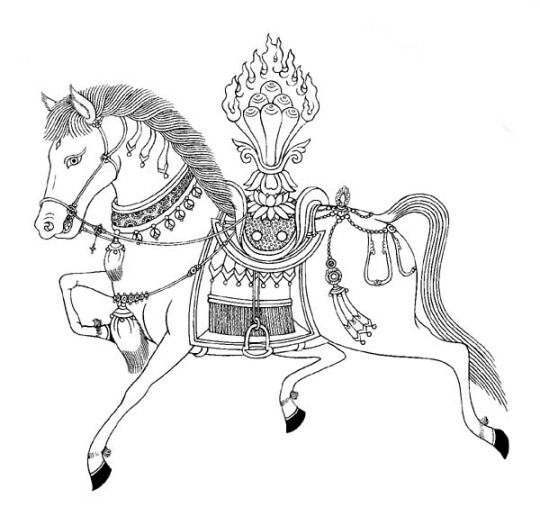
In East and Central Asian mythology, a wind horse is an important animal, representing several different things in different belief systems. It is known by various names, including "rlung ta" in Tibetan, "Khiimori" in Mongolian and "Rüzgar Tayi" in Old Turkic.
In Tibetan folk religion, the wind horse is a symbol of good fortune. It also represents the human soul in certain beliefs. The wind horse occasionally appears in heraldry, most notably as the State Emblem of Mongolia.
Image source.
Monster master list.
Suggest a spook.
#wind horse#windhorse#rlung ta#khiimori#rüzgar tayi#monster#supernatural#mythology#monsters#bestiary
51 notes
·
View notes
Text
Summary: Severia Zetsuen

Name: Severia Zetsuen
Alias/Nickname: none
Gender: female
Age: 28
Zodiac: Aquarius
Abilities/Talents: plays harp, flute, shamisen, xiao flute, morin khuur
Alignment: lawful / neutral / chaotic / good / neutral / evil / true
Religion: Grew up worshipping Azim and Nhaama. Currently questioning.
Sins: envy / greed / gluttony / lust / pride / sloth / wrath
Virtues: charity / chastity / diligence / humility / justice / kindness / patience
Languages: Eorzean Common, Old Auri, Doman. Currently learning Garlean.
Family: none
Friends: Thancred and the other Scions, Cid and the Ironworks crew.
Sexuality: heterosexual / bisexual / pansexual / homosexual / demisexual / asexual / unsure / other
Relationship Status: single / partnered / married / widowed / open relationship / divorced / not ready for dating / it’s complicated
Libido: sex god / very high / high / average / low / very low / non-existent
Build: slender / average / athletic / muscular / curvy / other
Hair: white / blonde / brunette / red / black
Eyes: brown / blue / gray / green / black / other (Red)
Skin: pale / fair / olive / light brown / brown / dark / other
Height: 5′2″
Scars: scarring on the underside of her wrists
dogs or cats || birds or bugs || snakes or spiders || coffee or tea || ice cream or cake || fruits or vegetables || sandwich or soup || magic or melee || sword dagger or bow || summer or winter || spring or autumn || past or future
A Few Songs That Remind Me of Them:
Gravity by Yoko Kanno
Kainé ~ Escape from Nier
Nuoen Jiya, Mongolian folk song
The Sore Feet Song from Mushishi
Tagged by: @starforger Thank you!
Tagging: anyone and everyone
2 notes
·
View notes
Text
The count goes on...
I scarcely noticed it, but last evening with the publication of my write-up on Fanchon, the Cricket (1915), I hit 750 full-length film write-ups on this blog. As you may know, the write-ups are tagged “My Movie Odyssey”. You can access every single write-up via the blog’s index. Some years ago, when I was putting out these write-ups and watching movies at a faster pace than I do now, I jokingly put a target of 1,000 write-ups for myself.
As I approach nine years on this site, this blog is now three-quarters of the way to that coveted century mark, hitting baseball hall of fame numbers if that number was counted as home runs. It would not have been possible without the support - through likes, reblogs, shares, comments, and simple reading the write-ups - of my followers present and past, and of course family and friends off of tumblr. For every write-up you have interacted with, I hope you were introduced to new ideas and perspectives, the filmmaking process, and how each of those films fit (or may someday fit) in the grander context of the history of one of the youngest artforms.
I admit that, if this year-long lockdown was good for anything, it has inspired a run of some of my best write-ups here on tumblr. Very few of these were on 2020 films, as I felt sorta liberated from the pressures from watching the newest releases (who has that much money for all those streaming services?). If you’ve missed them, here are a few highlights from some of my “COVID write-ups” so to speak...
Movie Odyssey Retrospectives on the Walt Disney Animation Studios canon: A long planned-for project that never got off the ground until last spring (and thanks to a friend sharing their Disney+ account). Reviews have included Disney’s Golden Age films like Snow White and the Seven Dwarfs (1937; this was write-up #700); Pinocchio (1940); Fantasia (1940); and Bambi (1942)... (1941′s Dumbo was written on a few years ago). Cinderella (1950) was published last month; this series continues hopefully this weekend with Alice in Wonderland (1951).
A Letter to Three Wives (1949): One of the finest pieces of feminist Americana I’ve ever seen, all thanks to Joseph L. Mankiewicz’s directing/writing and the stupendous performances from the three leads.
Diego Maradona (2019, United Kingdom): It is not often I feature soccer on this blog anymore. But when it comes along in the form of a write-up? I could never be more excited. This is Asif Kapadia’s documentary on the mercurial, controversial, and inflammatory late footballing genius of Diego Maradona. I wish it covered more time, but one can’t argue its effectiveness.
Ordet (1955, Denmark): As someone who was raised in a Buddhist family but was not raised with religion, I have always been fascinated by but nevertheless perplexed by narrative art that delves deeply into religious faith - especially in terms of the Abrahamic faiths (Christianity, Islam, Judaism). Probably one of my best efforts on a movie surrounding faith.
Once Upon a Time in America (1984): Epic-length gangster films are intimidating to write on. They hail from a place and time that I am very removed from - and I wish to stayed far removed from - and are so often celebratory of the “necessary” violence that they depict. Not this movie. This gangster epic is filled to the seams with regret. And I hope I conveyed that as effectively as I ever could.
Kaagaz Ke Phool (1959, India): Some of my best writing has come from write-ups of films that were deeply personal, if not fatefully biographical, for the filmmaker involved. You got that with Guru Dutt in his final film - a Bollywood box office failure but now largely considered one of the greatest examples of classic Hindi cinema. And, for those in the know, this film did pretty damn well in 2020′s MOABOS.
Tokyo Olympiad (1965, Japan): Another sports documentary? Well, this is not your typical sports documentary. This is an official film of the Olympic Games. And, other than Leni Riefenstahl’s propagandistic Olympia (1938, Germany), this is the most artistically accomplished of them all. And perhaps among the most important. I contextualize this film as essentially marking the beginning of Japan’s reintroduction to the world - perhaps not cinematically, but in the realms of politics, sport, and broader culture,
Flower Drum Song (1961): Before The Joy Luck Club (1993), the most recent film with an almost all-Asian cast was this. An adaptation of a famous Rodgers and Hammerstein musical that is never performed anymore (various reasons), it was a revelation to see so many actors of Asian descent that I had seen in bit roles in other movies or television star in this production. Even if that meant the film was not terribly culturally specific or accurate.
Wolfwalkers (2020): Another visual and thematic triumph from the folks at Cartoon Saloon in Ireland. There’s more to animation than just the major American studios and anime, as I hope many of you will learn if you haven’t already. Multinational European productions and Latin America are coming to the fore - and bringing ideas and visuals that the aforementioned American and Japanese studios could never produce.
The Cave of the Yellow Dog (2005, Mongolia): One of the gentlest films I’ve seen in the longest time. It plays like a fable, and - critically - like a lesson in learning how Mongolian nomads live without ever feeling like a university lecture. Wonderful performances from the non-professional actors, and an ideal watch for children.
Yi Yi (2000, Taiwan): A gorgeous portrait of a middle-class Taiwanese family as they navigate life’s messy current at the turn of the twentieth to twenty-first centuries. A pleasure to reflect on, however difficult actually writing this review was.
Thank you for your goodwill, support, and good humor for the first three quarters of this journey to a thousand Movie Odyssey write-ups. The fourth and final quarter begins. Onward.
1 note
·
View note
Text
are there any converts of color or born jewish poc who come from a background where you practiced folk religion or a nonreligious spiritual folk practice, thats non-jewish? whether it’s enmeshed with your judaism or a family member practices/ used to, it was your religion in the past, etc? who would be willing to answer a few questions for me about your experiences? and perhaps offer advice?
i make the distinction between religion and spiritual practice on purpose, and open to hearing both types of experiences, but i’m really hoping to talk to anyone who had spiritual practice/ belief rather than religion. and i ask in the first place because i have complex thoughts about conversion and my atheistic tengerist practices, and my mongolian jewish friend is no longer online and i don’t know who else to ask aside from a rabbi, which i’m not ready to talk to about this specific subject yet.
29 notes
·
View notes
Text
Kazakh Mongolian Tribe
General:
The Kazakhs of Mongolia are (like their brothers in Kazakhstan, Uzbekistan, China and Russia) a Turkic people originating from the northern parts of central Asia. They are the descendants of Turkic, Mongolic and Indo-Iranian tribes and Huns that populated the territory between Siberia and the black sea. Kazakhs trace their roots to the 15th century. In Mongolia, the Kazakhs form the largest minority and live mainly in the westernmost province of Baya-Ölgii, meaning 'rich cradle' in Mongolian. Most Kazakhs in this remote, mountainous region are dependent on domestic animals for their livelihood. Today the Kazakhs in the province of Bayan-Ölgii number around 87,000 or about 88.7 per cent of the provincial population, while across the country they represent around 4 percent of the total Mongolian population (about 110,000 people). They lean heavily on their clan and remember at least seven generations of their ancestors' names in order 'not to forget where they come from. Kazakh is the language of everyday communication, with Mongolian used for inter-ethnic interactions and official communication. Islam is the primary religion of the Kazakhs.
Lifestyle:
Today, many Kazakhs maintain traditional semi-nomadic herding by moving with their animals several times a year. A traditional yurt is a portable, round tent covered with skins or felt, and is used as a dwelling.Other with smaller herds stays closer to their winter home during the summer but will nevertheless set up a yurt (kiiz yi, meaning 'felt house'). the summertime yurt (and to a lesser extent the winter house) is richly furnished with embroidered, felt and woven textiles. Up until 1930, the nomads could freely move between Kazakhstan, Mongolia and the Chinese province of Xinijang. However, after the founding of the Mongolian people's republic in 1924, many of them gave up their semi-nomadic lifestyle and began settling down in the western Mongolian highlands. Walls are either made out of wood or bamboo and are arranged in an angled assembly or latticework. The traditional yurt furthermore has a door frame, ribs and a wheel. The roof structure is often self supporting, but large yurts may have interior posts supporting the crown.
All Kazakhs keep close ties to extended families. Tradition requires that one must not marry anyone related within 9 generations. As a result, upon meeting each other, Kazakhs always tell if and how they are related. Many of their cultural symbols reflect nomadic life. The horse is probably the most central part of Kazakh culture. Kazakhs love horses, riding them for transportation in the villages, using them for farming, racing them for fun, and eating them for celebrations. Many Kazakhs own horses and keep pictures of them in their houses or offices. Kazakhs are also very proud of their mountains, rare animals such as snow leopards, eagles, and falcons (a large eagle appears on the Kazakh flag under a rising sun), and their national instrument, the dombra, a two-stringed instrument with a thin neck and potbelly base, resembling a guitar. After dinner or while travelling, one will pull out a dombra, and play a traditional folk songs that reminds one of the time of the great warriors of Central Asia. The Mongolian Kazakhs, for example, have integrated Mongolian festivals within their own traditions. Buddhism is the biggest religion in Mongolia as a whole, but most Kazakhs are Sunni Muslims. Many Kazakhs in Mongolia now have their own spiritual identity, which combines Islam with their own traditions. They also consult shamans (priests who cure the sick by magic, communicate with the spirits, and control events) for both religious and political reasons. For hundreds of years, Kazakhs have been herders raising fat-tailed sheep, camels, and horses, relying on these animals for food, clothing and transportation. Mutton and horse are the preferred meats. There is widespread practice of salting and drying meat to preserve it, and there is a preference for sour milk, as it is easier to stone and therefore better suits their nomadic lifestyle. The Kazakhs indulge in richly embroidered clothing; women wear bright headscarves (ah jaulih) and men wear skullcaps (tuhia) or fox-fur hats. Kazakh culture is quite different from Mongolian culture: even Kazakh saddles are a different shape.
Traditions:
The most visible expression of tradition one will notice is the world famous art work of these nomadic people of the steppe. Kazakhs are famous around the world for their intricately embroidered wall hangings (tuskies) used on ger (yurt) walls. A typical ger may have 5 to 7 wall hangings that can take 200 hours to hand stitch each. The curving designs of the wall hangings are patterned after goat horns which symbolize the primary source of wealth of the nomadic herder. This design is used for a wide variety of traditional clothes, home furnishings, and accessories. The Kazakhs are not only known for their artwork, but also for their incredible friendliness.
The ancient art of eagle hunting is one of many traditions and skills that the Kazakh have held onto for the last decades. They rely on their clan and herds, believing in pre-Islamic cults of the sky, ancestors, fire and the supernatural forces of good and evil spirits. In mid-October, the Golden Eagle Festival signals the opening of the hunting season. It's a colourful and picturesque event attracting the best hunters and their birds. The biggest celebration is Nauryz, the Kazakh New Years, which is celebrated in March.
Kazakhs have a tradition of oral history. they lean heavenly on their clan and are supposed to remember al least seven generations of their ancestors' names in order 'not to forget where we come from'. in recent decades, the Mongolian Kazakhs have been able to hold on to their traditions and skills much more than their brothers in neighbouring Kazakhstan.
2 notes
·
View notes